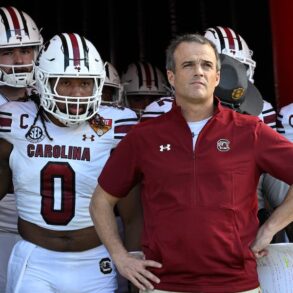Another day, another college commissioners’ meeting — and another conversation about potential College Football Playoff expansion that has ended without resolution. Or, as I like to put it, just your typical Wednesday in June.
“Pretty much everything’s on the table and they’re taking a good look at all of it,” CFP executive director Rich Clark told reporters in Asheville, N.C. “So I wouldn’t say there’s a leading contender right now for them, but they’re taking a fresh look at it.”
Round and round we go on a topic that never seems to go away completely. Even though there’s an easy (if boring) solution: The CFP should stay as is — at 12 teams.
Now, I get why there’s always at least one loud voice clamoring to expand the field. College football is a sport that has crowned its champion by polls and by computer algorithm. There’s always been incredible interest in a playoff model, even when college football didn’t have one. Then we got a four-team bracket, approved in 2012 and implemented in time for the 2014 season. Just one year into the 12-team era, commissioners now demand further expansion.
Will Hunter play both offense and defense in NFL?
Lawrence Jackson Jr. discusses recent comments made by Jaguars general manager James Gladstone about Travis Hunter, sharing why the 22-year-old rookie will likely be a productive fantasy football wide receiver in 2025.
The Big Ten has pushed for a 16-team bracket with multiple automatic qualifiers (AQs) per league, with the Big Ten and SEC each nabbing four designated spots — the so-called 4-4-2-2-1 model, which grants them double the number of AQs of the ACC and Big 12 with one spot designated for the highest-ranked Group of 5 champion. The SEC stunned those in Big Ten circles with its coaches publicly pushing for a 5+11 model — one AQ per league and the Group of 5, with 11 at-large spots — at its spring meetings last month.
The SEC’s interest in the 5+11 model aligns well with what’s best for both the ACC and Big 12, two leagues that did not want to accept a model that essentially defined them as second-tier conferences.
The posturing and preening over the past month has left the sport in a messy spot. It’s also uncharted territory, because any format changes made for the 2026-27 season do not require unanimity. Changes do require the Big Ten and SEC to agree on them, though, and the relationship between the two is in a far more tenuous place than it was six weeks ago. Multiple sources in the Big Ten have told NBC Sports that the conference will not support the 5+11 model if the SEC remains at eight conference games. (The Big Ten plays nine.)
As the CFP expansion debate stretches further into the doldrums of the summer, even the Big Ten’s coaches are jumping into the fray.
https://x.com/NicoleAuerbach/status/1935104742679519328
It is quite possible that the current Big Ten-SEC standoff delays or stymies bracket expansion. Any format changes for the 2026-27 season need to be decided on and communicated to ESPN by Dec. 1.
But if the Big Ten and SEC can’t come to an agreement on a specific 16-team format by that date, the expectation is that the Playoff would simply move forward in its current iteration — with 12 total teams, including five conference champions and seven at-large selections.
And, frankly, that is the best possible outcome.
The 12-team CFP worked out exceptionally well in its first year. More teams had access to the sport’s premier postseason than ever before, which meant dozens of teams that previously would have been eliminated were still fighting for spots in the final weeks of the regular season. Increased access led to increased engagement by fans. First-round games on campus were as electric as we had hoped they would be. Even early round blowouts turned out to be a blessing in disguise, as they set up some great quarterfinal games and excellent, evenly matched semifinals.
Will NIL lead to players becoming ‘commodities’?
Dan Le Batard and the Shipping Container lay out some of the further-reaching effects of NIL at the college sports level, examining how youth sports can be affected and players risk being turned into ‘commodities’.
Even with just one season’s worth of data, it’s clear that there aren’t actually going to be 12 teams truly capable of winning a national title, that there are perhaps only six to eight built to get to the finish line. But it is obvious, too, that the very best teams in college football will fall within the 12 teams picked to participate year in and year out. Teams No. 13 or 14, on the wrong side of the cut line, were flawed teams that had lost to lesser opponents multiple times. The first team out of any field will always complain, but that exclusion felt far different from the Bowl Championship System era or even the four-team bracket days. In the past, we all worried that the best team in the country might not have a chance to play for a national championship. That’s no longer a fear in a 12-team world, because the buffer is so wide.
The only real problem with Year 1 of the 12-team CFP era was the way its convoluted seeding system worked — and that issue got fixed this offseason. Straight seeding 1-12 means a balanced bracket, and it also means that the four best teams (per the selection committee) are the four teams that get first-round byes. That is how the system should work, and it will give us more competitive, evenly matched early-round games.
The 12-team format worked well, and it’s going to work even better with straight seeding. But this sport’s leaders are impatient; they started discussing expanding beyond 12 teams before a single CFP game was played last winter. They assume bigger is better just because. Their bloated leagues need more access points, so they like the idea of 16 more than they do 12, even if the status quo is a pretty great solution to the problems that have ailed college football. The current format is fundamentally fair, and it will help the sport continue to evolve from its regional roots to its status as a national behemoth.
Ultimately, the Big Ten and SEC will surely figure out a way to work together again. The current standstill may just be a momentary (fortuitous?) blip. But while we’re here and while we’re paused, I hope the sport’s leaders take a second to look around. The grass isn’t always greener someplace else. Sometimes, it’s best to stay put.
This post was originally published on this site be sure to check out more of their content.






